How To Market Primary Care Practice (PCPs) $799/mon to $999/mon
An Effective Patient Acquisition & Engagement Strategy For Primary Care Clinics Requires Much More than a Website and a Social Media Page
For many PCP practices and physicians, their attempts to become more integrally connected with patients are often obstructed by a lack of effective online marketing & patient communication tools. In order to improve your practice’s ability to communicate with patients, keep past patients engaged with your clinic, and prevent broken appointments, you need effective software tools. There are approximately 300,000 PCPs in USA alone. This includes doctors, NPs and PAs. However thousands of them suffer every month due to lack of patients. And the number one reason is lack of marketing.
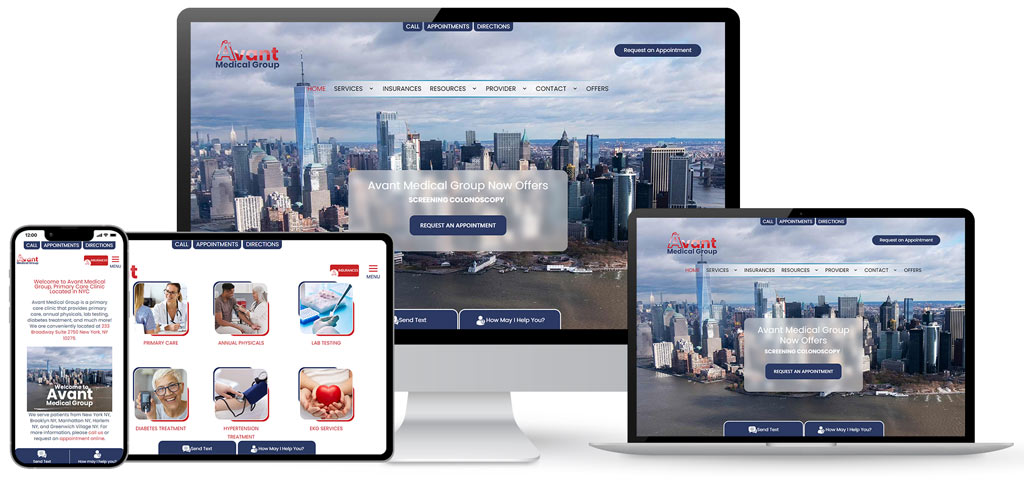
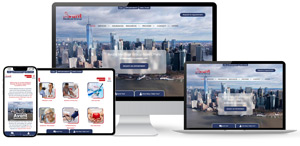
| Primary care providers in USA | Number |
|---|---|
| Physicians | 208,807 |
| Nurse practitioners | 55,625 |
| Physician assistants | 30,402 |
| Total | 294,834 |
Patient acquisition & retention has been automated by using PatientGain’s solutions
Primary Care doctors and practices across the US have boosted their patient retention and created lasting patient relationships by simply adding PatientGain.com Apps to their existing Website and Facebook business page, or using the GOLD solution from PatientGain.
With PatientGain.com Patient Engagement software, you’ll be able to put intelligence and software automation behind your website, allowing your practice to increase patient recalls, prevent broken appointments, effectively communicate health advisories, and improve your patients’ wellness and compliance.
Example 1 of a high SEO and high conversion primary care website
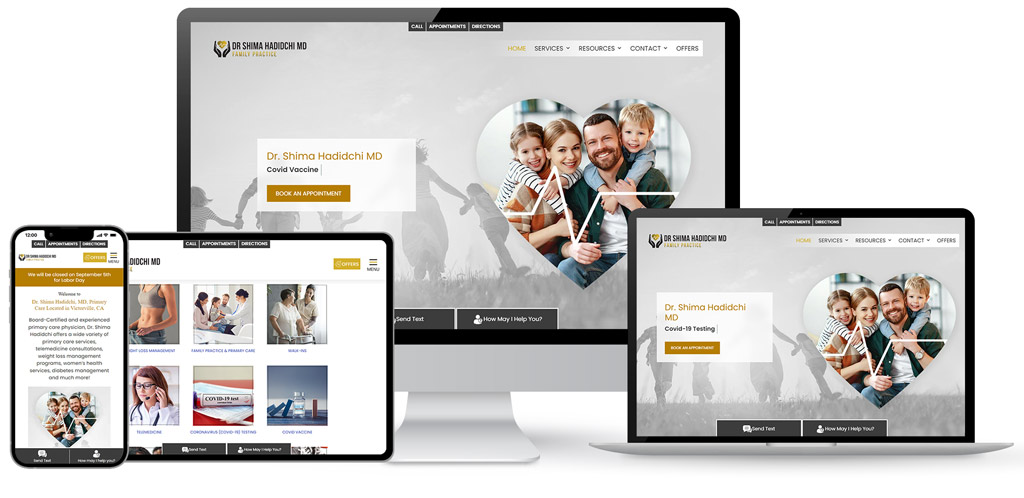

Example 2 of a high SEO and high conversion primary care mobile website.
Your mobile website must have these characteristics:
- Must load very fast on mobile devices. It should also be mobile optimized
- The structure of the website should be designed for conversion. only 4.3 percentage of primary care websites are designed for conversion
- Content of the website should be unique and should never be plagiarized.
- The website should be running on secure servers
- There should be a HIPAA compliant CRM behind the website
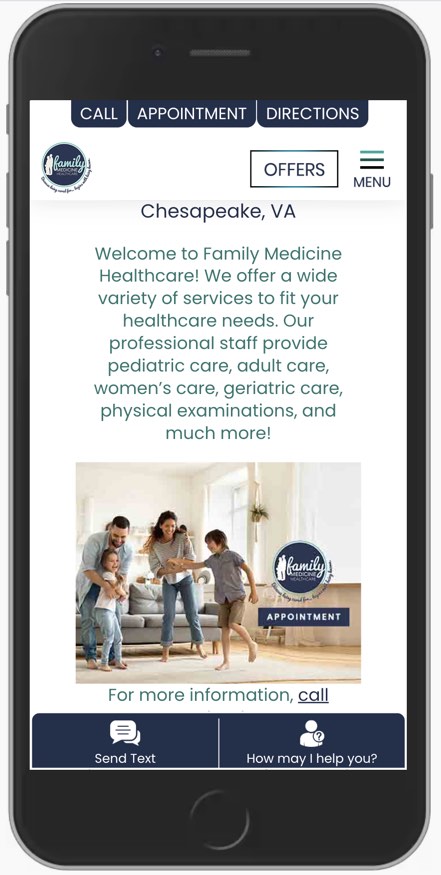
Example 3 of a PCP in Texas, who only accepts cash patients. PCP is a NP and offers membership pricing, but does not accept insurance.
From the data below, the first month launch, using PatientGain’s GOLD service and $1200 per month advertising budget on Google ads. This is a brand new PCP practice, located outside Houston in a suburb, with healthy competition. In the report below, effective leads 14.

Exactly one year, 12 months later. From the data below, the ads budget $1200 per month on Google ads was not changed. In the report below, effective leads 151. The conversion rate of this practice is very high.

6 months later. From the data below, the ads budget $1200 per month on Google ads was not changed. In the report below, effective leads 356. The advertising budget has remained the same, however the SEO has grown significantly. Each location is different, so your results will vary.

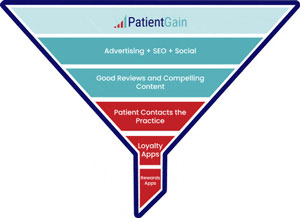

Marketing Examples for Family Medical Practices
Marketing strategy to help primary care practices effectively grow their patient base and strengthen their reputation.
1. Build a Professional Online Presence
- Website Design:
- Example: A family clinic builds a clean, professional website featuring:
- Service pages like “Annual Physicals,” “Chronic Disease Management,” and “Vaccinations.”
- A “New Patient” section with downloadable forms to save time during visits.
- An “Ask the Doctor” blog series where physicians answer common health questions like “How Often Should I Have a Check-Up?”
- Objective: Increased patient inquiries within three months due to improved online usability.
- Example: A family clinic builds a clean, professional website featuring:
- Search Engine Optimization (SEO):
- Example: The clinic targets phrases like “primary care near me” or “family doctor accepting new patients in [City].” Blogs and service pages are optimized with these terms, including internal links and FAQs.
- Objective: Ranks on the first page of Google for key terms, driving organic traffic growth.
2. Optimize Local SEO
- Google My Business:
- Example: A clinic uploads images of their staff, waiting area, and exam rooms. Weekly updates include posts about flu shot availability or holiday hours.
- Objective: Increases local search views monthly, with 18% converting into inquiries.
- Geo-Targeted Content:
- Example: Publish blogs like “Common Allergies in [City]: Prevention and Treatment” or “Top 5 Reasons [City] Residents Should Schedule a Wellness Exam.”
- Objective: Attracts patients from the local area searching for these health topics.
3. Leverage Social Media
- Engaging Posts:
- Example: Post weekly tips on Facebook, such as “How to Beat the Common Cold,” and encourage followers to ask questions in the comments.
- Objective: Boosts social engagement, with several followers converting to new patients.
- Live Q&A Sessions:
- Example: Host an Instagram Live session titled “Ask the Doctor: Preventing the Flu” where a physician answers viewer questions in real-time and provides links for scheduling flu shots.
- Objective: 100 live viewers.
- Patient Testimonials:
- Example: Share a video testimonial from a patient explaining how the clinic helped manage their diabetes.
- Objective: Builds trust and inspires others with similar conditions to seek care at the clinic.
4. Email and SMS Marketing
- Seasonal Health Campaigns:
- Example: Send an email with the subject line “Back-to-School Checklist: Schedule Your Child’s Physical Today!” Include a link to online booking and a list of what the physical covers.
- Objective: Increased physical exam appointments.
- Appointment Reminders:
- Example: Use SMS automation to send reminders 48 hours and 2 hours before an appointment, with options to confirm or reschedule.
- Objective: Reduced no-shows by 18%, saving the clinic thousands in lost revenue.
- Educational Newsletters:
- Example: Monthly newsletters feature topics like “Managing High Blood Pressure” or “Why Annual Wellness Exams Are Important.” Include CTAs to book related services.
- Objective: Patients are more engaged and schedule services they hadn’t considered previously, like cholesterol checks.
5. Promote Convenience and Accessibility
- Online Booking and Telehealth:
- Example: A telehealth banner on the clinic’s homepage reads: “See Your Doctor From Home—Book a Virtual Visit Today!” Promote the feature on social media.
- Objective: Increased telehealth visits, especially among busy professionals.
- Same-Day Appointments:
- Example: Highlight same-day availability on the clinic’s website and in Google Ads with phrases like “Same-Day Sick Visits—Call Now or Book Online!”
- Objective: Attracted 20 new patients within the first week of the campaign.
6. Community Involvement
- Health Fairs:
- Example: A clinic hosts a booth at the city’s annual health fair, offering free blood pressure screenings and distributing branded first-aid kits with their logo and contact information.
- Objective: Gained 50 new patient sign-ups during the event.
- Educational Workshops:
- Example: Hold an in-person seminar titled “How to Prevent Diabetes” in collaboration with a local community center. Provide handouts summarizing key points and include a link to schedule consultations.
- Objective: 10 attendees booked follow-up visits for diabetes screening and management.
- Sponsorships:
- Example: Sponsor a local school’s soccer team by providing jerseys with the clinic’s logo. Use the sponsorship to build goodwill and recognition.
- Objective: Increased awareness and trust among local families.
7. Highlight Services with Promotions
- Seasonal Promotions:
- Example: During flu season, promote discounted flu shots on Facebook and through email with the tagline “Stay Healthy This Winter—Flu Shots for Only $25.”
- Health Packages:
- Example: Offer a “Wellness Check-Up Package” for new patients, bundling an annual exam, basic labs, and vaccinations at a reduced price.
- Objective: Attracted self-pay patients.
8. Reputation Management
- Encourage Reviews:
- Example: After every appointment, send patients a text thanking them for their visit and asking them to leave a Google review if they’re satisfied with their experience.
- Objective: Collected over 100 positive reviews in six months, boosting the clinic’s online rating from 4.0 to 4.8 stars.
- Respond to Reviews:
- Example: A patient leaves a 3-star review due to a long wait time. The clinic replies with an apology, explains the situation, and offers to address the concern. The patient updates their review to 5 stars.
- Objective: Showcases the clinic’s commitment to patient satisfaction.
9. Paid Advertising
- Google Ads:
- Example: Run a Google Ads campaign targeting keywords like “primary care accepting new patients” with ad copy emphasizing same-day appointments and a family-friendly atmosphere.
- Objective: Attracted 67 new inquiries in a month.
- Facebook Ads:
- Example: Promote wellness checks with an ad that reads, “Keep Your Family Healthy—Schedule Your Annual Exam Today!” Include a booking link.
- Objective: Increased wellness exam bookings by 5%.
10. Patient Education
- Blog Content:
- Example: Write articles like “How to Manage High Cholesterol” or “The Benefits of an Annual Physical” and promote them on social media and newsletters.
- Objective: Attracts patients seeking information and positions the clinic as an expert in preventive care.
- Video Marketing:
- Example: Create a YouTube video featuring a doctor explaining “What Happens During a Wellness Exam.” Share on the clinic’s website and social media.
- Objective: Video gets views and leads to increased interest in wellness exams.
11. Loyalty Programs and Referrals
- Referral Incentives:
- Example: Offer a $20 credit toward a future visit for each new self pay patient referred by an existing patient.
- Loyalty Program:
- Example: Reward long-term patients with discounts on services like lab tests or follow-ups after a certain number of visits.
- Objective: Boosted patient retention rates by 12%.
12. Data-Driven Optimization
- Analyze Campaign Performance:
- Example: Track PPC ads and discover that “family doctor near me” yields the highest conversions. Shift more budget to ads targeting similar keywords.
- Objective: Improved ad ROI by 9%.
- Patient Surveys:
- Example: After appointments, email surveys asking for feedback on wait times, staff friendliness, and overall experience.
- Objective: Identified and resolved bottlenecks, leading to a smoother patient experience.
How much do doctors spend on advertising in USA?
Range is $600 per month to $15000 per month, depending on specialty and competition.
The actual advertising budget for each clinic and practice is different. Some clinics/doctors are very aggressive and spend $1000 per day (or more) and some spend $1000 a month on advertising. We also have few clinics/doctors who do not spend any money on online advertising, they doctors rely on referrals and very strong SEO rankings. This data refers to online advertising, not offline advertising spend.
Also you have to understand that every practice area is different. For example let’s review specific specialties:
Primary care practices
Primary care doctors spend $600 to $2400 per month, with an average monthly budget of $1690 per month.
Naturopathic, wellness focused care practices
Primary care doctors spend $800 to $1900 per month, with an average monthly budget of $1230 per month.
Walk-in primary care practices
Walk-in Clinics – with primary care services and some “urgent care” services spend $1000 to $3400 per month, with an average monthly budget of $2600 per month.
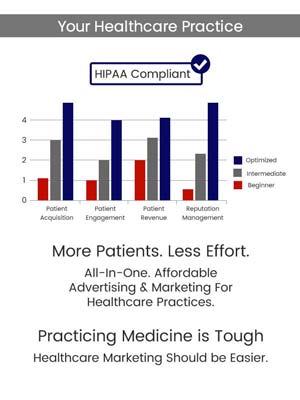
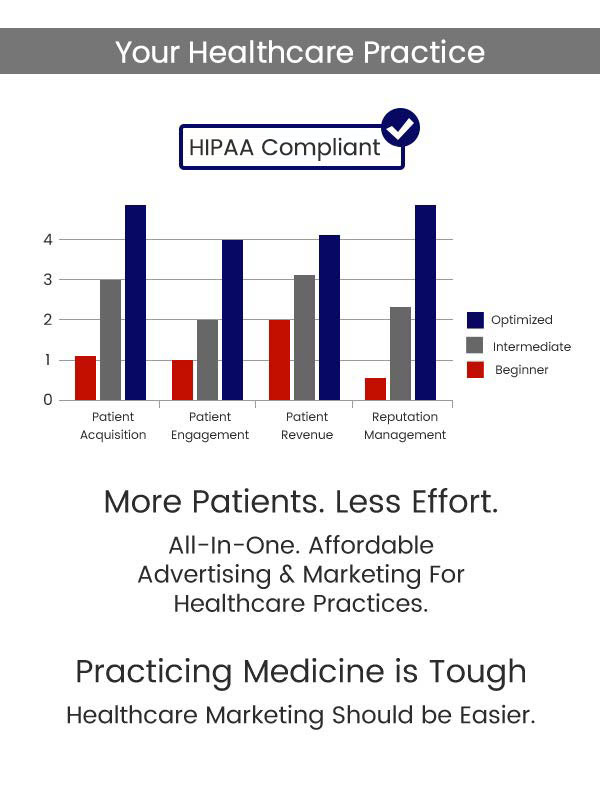
The experts at PatientGain.com are available to help you create a high-performance healthcare website for a family medical practice. Contact us today, and let us show you what we have done for other practices across the country!
